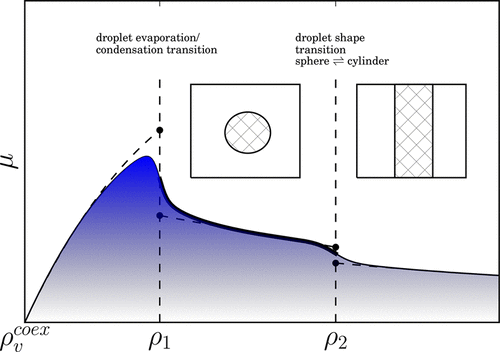当前位置:
X-MOL 学术
›
J. Phys. Chem. B
›
论文详情
Our official English website, www.x-mol.net, welcomes your feedback! (Note: you will need to create a separate account there.)
Equilibrium between a Droplet and Surrounding Vapor: A Discussion of Finite Size Effects
The Journal of Physical Chemistry B ( IF 3.3 ) Pub Date : 2017-12-08 00:00:00 , DOI: 10.1021/acs.jpcb.7b10392 Andreas Tröster 1 , Fabian Schmitz 2 , Peter Virnau 2 , Kurt Binder 2
The Journal of Physical Chemistry B ( IF 3.3 ) Pub Date : 2017-12-08 00:00:00 , DOI: 10.1021/acs.jpcb.7b10392 Andreas Tröster 1 , Fabian Schmitz 2 , Peter Virnau 2 , Kurt Binder 2
Affiliation

|
In a theoretical description of homogeneous nucleation one frequently assumes an “equilibrium” coexistence of a liquid droplet with surrounding vapor of a density exceeding that of a saturated vapor at bulk vapor–liquid two-phase coexistence. Thereby one ignores the caveat that in the thermodynamic limit, for which the vapor would be called supersaturated, such states will at best be metastable with finite lifetime, and thus not be well-defined within equilibrium statistical mechanics. In contrast, in a system of finite volume stable equilibrium coexistence of droplet and supersaturated vapor at constant total density is perfectly possible, and numerical analysis of equilibrium free energies of finite systems allows to obtain physically relevant results. In particular, such an analysis can be used to derive the dependence of the droplet surface tension γ(R) on the droplet radius R by computer simulations. Unfortunately, however, the precision of the results produced by this approach turns out to be seriously affected by a hitherto unexplained spurious dependence of γ(R) on the total volume V of the simulation box. These finite size effects are studied here for the standard Ising/lattice gas model in d = 2 dimensions and an Ising model on the face-centered cubic lattice with 3-spin interaction, lacking symmetry between vapor and liquid phases. There also the analogous case of bubbles surrounded by undersaturated liquid is treated. It is argued that (at least a large part of) the finite size effects result from the translation entropy of the droplet or bubble in the system. This effect has been shown earlier to occur also for planar interfaces for simulations in the slab geometry. Consequences for the estimation of the Tolman length are briefly discussed. In particular, we find clear evidence that in d = 2 the leading correction of the curvature-dependent interface tension is a logarithmic term, compatible with theoretical expectations, and we show that then the standard Tolman-style analysis is inapplicable.
中文翻译:

液滴与周围蒸气之间的平衡:有限尺寸效应的讨论
在均相成核的理论描述中,人们经常假设液滴与周围蒸气的“平衡”共存,其密度大于在整体气液两相共存时的饱和蒸气的密度。因此,人们忽略了一个警告,即在热力学极限中,蒸汽将被称为过饱和状态,这种状态充其量只能在有限的寿命内保持亚稳态,因此在平衡统计力学中无法得到很好的定义。相反,在有限体积的系统中,液滴和过饱和蒸气在恒定总密度下的稳定平衡共存是完全可能的,并且有限系统的平衡自由能的数值分析可以得到物理上相关的结果。尤其是,R)在液滴半径R上通过计算机模拟。然而,不幸的是,这种方法产生的结果的精度受到迄今为止无法解释的γ(R)对仿真盒总体积V的虚假依赖性的严重影响。对于d中的标准伊辛/晶格气体模型,本文研究了这些有限尺寸效应= 2维,并且在面心立方晶格上具有3旋相互作用的Ising模型,汽相和液相之间缺乏对称性。还处理了类似的情况,即气泡被不饱和液体包围。有人认为(至少很大一部分)有限尺寸效应是由系统中液滴或气泡的平移熵引起的。对于平板几何图形中的模拟,平面界面也早已显示出这种效果。简要讨论了估算托尔曼长度的后果。特别是,我们找到明确的证据表明,在d = 2取决于曲率的界面张力的前导校正是对数项,与理论期望相符,并且我们证明了标准的托尔曼式分析不适用。
更新日期:2017-12-08
中文翻译:

液滴与周围蒸气之间的平衡:有限尺寸效应的讨论
在均相成核的理论描述中,人们经常假设液滴与周围蒸气的“平衡”共存,其密度大于在整体气液两相共存时的饱和蒸气的密度。因此,人们忽略了一个警告,即在热力学极限中,蒸汽将被称为过饱和状态,这种状态充其量只能在有限的寿命内保持亚稳态,因此在平衡统计力学中无法得到很好的定义。相反,在有限体积的系统中,液滴和过饱和蒸气在恒定总密度下的稳定平衡共存是完全可能的,并且有限系统的平衡自由能的数值分析可以得到物理上相关的结果。尤其是,R)在液滴半径R上通过计算机模拟。然而,不幸的是,这种方法产生的结果的精度受到迄今为止无法解释的γ(R)对仿真盒总体积V的虚假依赖性的严重影响。对于d中的标准伊辛/晶格气体模型,本文研究了这些有限尺寸效应= 2维,并且在面心立方晶格上具有3旋相互作用的Ising模型,汽相和液相之间缺乏对称性。还处理了类似的情况,即气泡被不饱和液体包围。有人认为(至少很大一部分)有限尺寸效应是由系统中液滴或气泡的平移熵引起的。对于平板几何图形中的模拟,平面界面也早已显示出这种效果。简要讨论了估算托尔曼长度的后果。特别是,我们找到明确的证据表明,在d = 2取决于曲率的界面张力的前导校正是对数项,与理论期望相符,并且我们证明了标准的托尔曼式分析不适用。



























 京公网安备 11010802027423号
京公网安备 11010802027423号